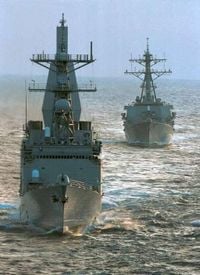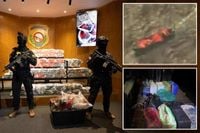In a high-stakes operation that unfolded on September 15, 2025, the United States military and Dominican authorities intercepted and destroyed a speedboat in international waters of the southern Caribbean, seizing an estimated 1,000 kilograms of cocaine in the process. This dramatic maritime confrontation, announced by the Dominican National Directorate for Drug Control (DNCD) on September 22, has sent ripples through regional security circles and reignited debate about the ever-evolving war on drugs in the Caribbean basin.
The intercepted vessel, a so-called "Go Fast" speedboat, was detected roughly 80 nautical miles south of Isla Beata, a remote island under Dominican sovereignty. According to the DNCD, the operation was the result of close coordination between Dominican naval forces, the U.S. Southern Command (Southcom), and the Joint Interagency Task Force South (JIATF-South). Intelligence reports had flagged the boat as being loaded with narcotics, and authorities believed it was attempting to use the Dominican Republic as a bridge to transport cocaine from South America to the United States.
"The operation disrupted one of the most significant shipments intercepted in months," Dominican officials declared in their statement, as reported by multiple outlets including Fox News and France 24. The DNCD emphasized that U.S. assistance had been vital in neutralizing the smugglers’ chances of reaching Dominican shores, and in preventing the drugs from entering global narcotics networks. The seized cocaine—377 packages in total, with a combined weight of approximately one metric ton—was sent under chain of custody to the National Institute of Forensic Sciences (INACIF) to confirm its type and weight.
For the United States, this mission is part of an intensified campaign to stymie the flow of cocaine before it ever reaches American soil. In August, the U.S. escalated its military presence in the southern Caribbean, deploying eight warships and a submarine to the region. These moves, according to the White House, are aimed squarely at dismantling organized drug networks—particularly those linked to Venezuela, whose president, Nicolás Maduro, has been repeatedly accused by U.S. officials of leading the so-called Cartel of the Suns. Maduro, for his part, has vehemently denied these allegations, characterizing the U.S. naval presence as an act of aggression against his country.
The operation is emblematic of a broader U.S. policy known as "forward defense," which seeks to intercept drug shipments far from American shores. President Donald Trump, who has ordered several such strikes this month, made his stance clear on social media: "IF YOU ARE TRANSPORTING DRUGS THAT CAN KILL AMERICANS, WE ARE HUNTING YOU!" he warned in a Truth Social post about one of the strikes. The U.S. Navy and Coast Guard have ramped up patrols across the Caribbean Basin, especially in the Mona Passage and waters near Puerto Rico, hoping to increase traffickers’ risks and deter future shipments.
The destruction of the boat and seizure of such a large volume of cocaine—valued at more than $25 million on the street—represents a severe financial blow to drug cartels. For traffickers, losing a shipment of this scale doesn’t just hurt immediate profits; it disrupts logistics, damages reputations, and can spark rivalries or tensions within criminal networks. According to France 24, the Caribbean remains a critical corridor for narcotics shipments, with traffickers constantly adapting their routes to evade law enforcement.
Yet the operation has not been without controversy. Human rights groups have voiced concern over the aggressive tactics employed, particularly the use of lethal force and the destruction of vessels at sea. Since the U.S. ramped up its presence in August, three drug-carrying speedboats have been destroyed, resulting in the deaths of more than a dozen individuals aboard, according to reports cited by France 24 and Fox News. Critics argue these strikes amount to extrajudicial killings, and the lack of transparency over the decision to destroy boats rather than seize them has fueled further debate.
The political ramifications have not gone unnoticed in Washington. Two Democratic senators introduced a resolution last week aiming to curtail the administration’s military actions against drug traffickers in the region. The move underscores the growing unease among lawmakers about the consequences of such military interventions, particularly in a region already fraught with geopolitical tensions.
For the Dominican Republic, the operation marks a historic milestone in its partnership with the United States. President Luis Abinader and other officials have lauded the collaborative approach, pointing to the operation as a model for future joint efforts. The DNCD noted that cocaine trafficking remains one of the most pressing threats to Caribbean nations, as traffickers frequently exploit maritime routes that branch across smaller islands. The Dominican Republic’s geographic position makes it a critical point on these routes, and officials have stressed that crackdowns are necessary to prevent the country from becoming a hub for organized narcotics activity.
However, the risks are not limited to international trafficking. While many shipments are not intended for local markets, the transshipment of drugs creates dangers of local distribution, violence, and corruption. Community groups and citizens in Santo Domingo have called for continued vigilance, urging authorities to protect Dominican waters and coasts from becoming battlegrounds for organized crime.
International experts warn that traffickers are nothing if not adaptive. When shipments are lost on one route, new pathways and tactics quickly emerge. For Caribbean states already grappling with limited naval and aerial resources, the challenge of remaining vigilant requires constant collaboration with partners like the U.S. and neighboring islands. As Fox News reported, the DNCD has expanded intelligence-sharing operations, making use of lookout points and logistical hubs for anti-trafficking missions.
The broader context of the operation cannot be ignored. The escalating U.S. military presence in the Caribbean has heightened tensions with Venezuela, adding a layer of geopolitical complexity to what is already a fraught security environment. The seizure of 1,000 kilograms of cocaine is a victory for law enforcement, but it also serves as a stark reminder of the high stakes and constant evolution of the drug trade in the region.
As the dust settles from this latest operation, both the Dominican Republic and the United States are left to weigh the benefits of aggressive interdiction against the risks—legal, political, and humanitarian—of military engagement at sea. For now, the seizure stands as a testament to the power of international cooperation, even as it raises new questions about the future of the fight against narco-trafficking in the Caribbean.
While the battle against drug cartels is far from over, the recent events underscore the necessity—and the cost—of vigilance on the high seas.


